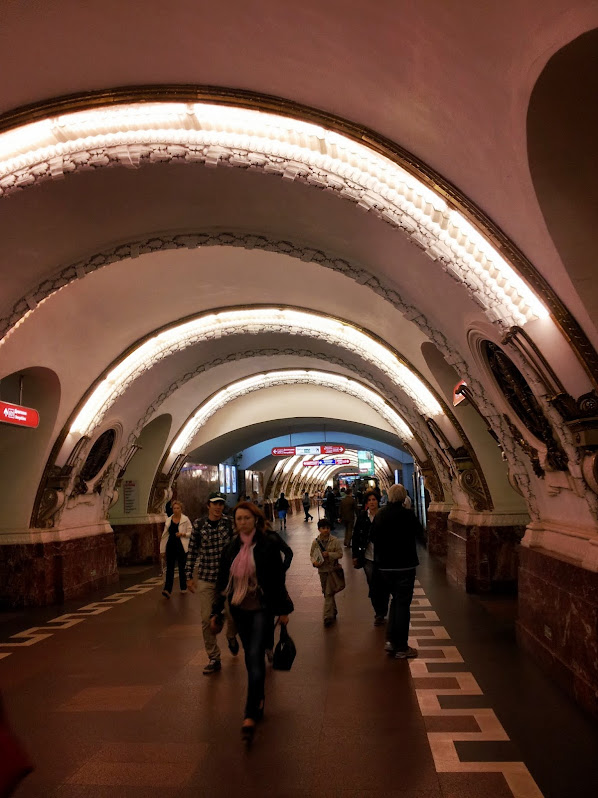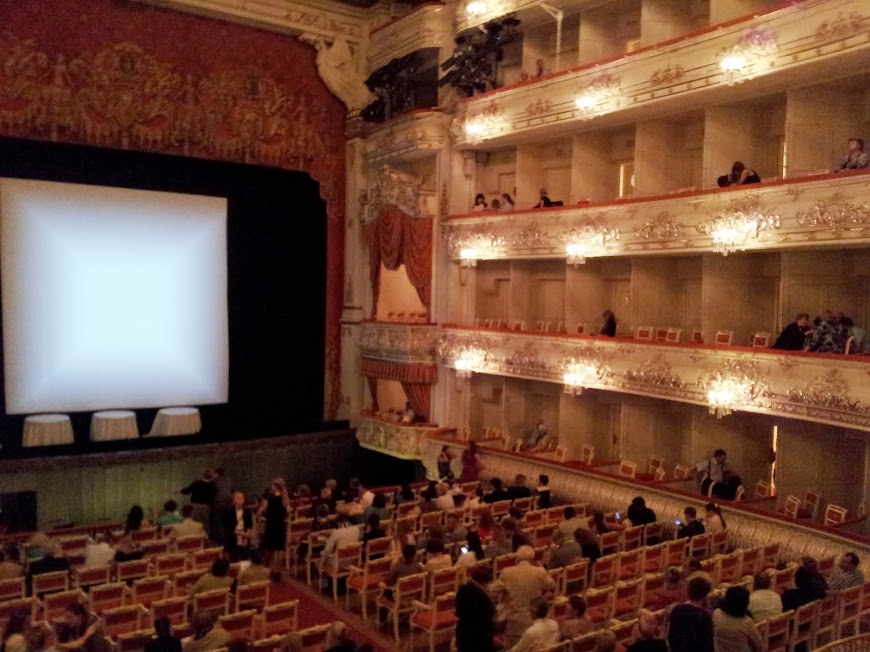St Petersburg
St Petersburg was founded by Peter the Great after his military success against Charles 12 of Sweden; the aim of which was to secure a port on the Baltic and give previously land-locked Russia access to the sea and new trade routes. Peter was a product of the Enlightenment; very well educated and well-travelled; including to England where he studied ship design.
As the site for the new city was swamp at the head of the gulf of Finland and would require canals for drainage he decided on a city modelled on Amsterdam; and imported European architects engineers and builders to construct this planned city. The result is one of the most beautiful of European cities; particularly when it is bright and sunny as it was for us.
St Petersburg is a city of canals
The city was further developed by his daughter Elizabeth and by Catherine the Great.
The city has been home to some of Russia's greatest writers; composers; and artists. In many cases the building in which they lived is now preserved and can some can be visited - list...
During the Soviet Period the City was known as Leningrad and was famously unsuccessfully besieged by the Germans in World War 2 (WW2).
Modern additions to the city include a metro that is, on average, the deepest in the World. We found it amazing. The escalators disappear into the distance below you and then, quite often, there is yet another flight before you reach your platform. It is a lot smaller than Moscow (5 lines and 67 stations) but again some of the stations are elaborately decorated.

Other stations are not as 'user friendly' because platform doors, that open to correspond to those on the train, are interspersed with solid concrete. So, catching a train is like waiting for a row of lifts in a bunker; and when you are on the train there is little indication of which station you have arrived at except an announcement in Russian. This usually fails to correspond to the expected pronunciation of the English station name, as displayed on the map. Think of the poor foreigners arriving at Marylebone or Streatham tube stations in London.
Again, we used the Metro to get about the city; particularly once we had left the cruise and moved to a hotel for a few days.
Among the sites popular with Tourists are some unique churches. One of these popularly known as the Church of Spilled Blood (Church of the Saviour on Blood) built on the site of the assassination of Alexander II in 1881, he who emancipated the serfs.
Church of Spilled Blood
This church was almost destroyed by German shellfire during the Siege of Leningrad but it has been completely restored except for just one external panel, deliberately left damaged in remembrance. This work was commenced during the Communist period and has involved the intricate remaking of many hundreds of heavily gilded mosaic panels depicting saints and scenes from the bible; involving millions of tiles. The result is spectacular.
All the images are in mosaic - millions of tiles - all restored since 1945
The same effort has been put into other buildings damaged by the Germans. The palaces of the former aristocracy have been lovingly restored and refurnished within and around St Petersburg largely during the Communist period. What were they thinking? Was this proof that the Germans had left no scar; or was it an elaborate demonstration of the, often crass and tasteless, excesses of the Tsarist period; or was it done with an eye to future tourism?
Anyway, out tour guides made sure that we visited the most extreme examples and we used some of our time, after the cruise, to visit several others.
The Hermitage
St Petersburg has a considerable array of cultural attractions including galleries; museums and opera houses. Principal among these is the Hermitage, a series of linked palaces along the waterfront that holds the Tsarist collection of artworks that include Renaissance works by Leonardo da Vinci; Titian and Raphael; Flemish works including Rembrandt and Hals; and later Russian and European works; including a large collection of impressionists including Van Gogh; Matisse; Monet and Gauguin and a number of cubists, including Picasso.
The Hermitage - bottom right is not a painting - it's the view out a window
Although entering with a guide by-passed the entry queue there seemed to be a strict limit to the galleries that guides were permitted to take groups to. Fortunately, there was free time. But in our group only two of us were able to find our way the impressionists; so, I took extensive photographs in that section. You can see a sample of the rest of the collection online.
Worldwide some large collections like: the Hermitage; both Tate collections in London; those in Edinburgh; and most major US galleries; allow photography without flash. But several in Russia like the National Portrait Gallery in London, do not.
As I'm interested in technique, I'm disappointed if I can't take a few close-up shots of brush strokes. It's seems a bit ridiculous, now that mobile phones have quite good cameras and, in any case, paintings that have been varnished or are behind glass are often quite reflective and can't easily be photographed, in toto, in sufficiently good quality to compete with already published reproductions.
The net outcome is that you have been spared from pictorial commentary on several other collections that I enjoyed on this trip.
The Opera
We also went with Craig and Sonia to the Opera at the Mikhaleovsky; to see Peter Tchaikovsky's Eugene Onegin. Again, we did this independently of the tour operator.

While the music was fine and the singing excellent the staging was surreal.
It's based on a novel by Pushkin. As Tchaikovsky apparently admitted, it has a rather weak plot - a dandy rejects a young country girl, she successfully grows into a worldly woman, he tries to seduce her but it is too late. So its strength is said to lie in character development and social commentary, as well as in the beauty of its delivery and Pushkin's poetry.
Unfortunately, most of this beauty and biting satire at the expense of the upper classes was lost on us as it was, obviously, sung in Russian.
Worse, from Wendy's point of view, there were no sumptuous ball gowns or fine clothes and not even any visible dancing; despite several waltzes. Instead, the production was bizarrely modern and monochromatic. Initially white on white it later became black on white then black on black. There were no dancing peasants and the chorus was kept behind a screen at the back of the stage. From time to time they could be seen through the windows, when these weren't being whipped by stormy tree branches; that latterly turned to autumn leaves blown onto the stage.
In place of the usual sumptuously dressed chorus, modern domestic appliances occupied the stage: washers, fridge and microwave oven. These were tended by mute domestic staff in black and white; including an apparently mad butler.
Quite early, a dwarf silently emerged from the fridge and thereafter kept reappearing from various appliances, cupboards and a grandfather clock, sporting and increasingly long beard (father time).
At different times Tatyana, the lead soprano, dressed all in white, was showered in black beads from a bucket or pricked by giant rose thorns that emerged, stem first, from the fireplace; the mantel of which was used as a very high love seat during one duet.
At different times dark glass bottles were thrown about the white stage by the principals and domestic staff; on one occasion, apparently accidently, hitting a string of bare light bulbs that had been strewn across the stage; spectacularly bursting one bulb. At another Eugene repeatedly used an air rifle to burst a string of balloons. On yet another the principals, assisted by staff, spun white plates for some minutes, during the orchestral introduction to Act three.
After the duel, in which Eugene kills his friend Lensky, the dead tenor was laid in the, now fallen, grandfather clock, as a coffin, and about 20 litres, of what appeared to be milk, were poured over his head.
Towards the end numerous clocks were brought onto the set by staff only to be removed, rather more violently; being pulled down and thrown out of a window by Eugene. The Dwarf too was then picked up and thrown out the window. Hopefully someone was waiting to catch him. Later in the scene, the apparently distracted, Eugene took up a set of throwing knives and proceeded to throw them in a circle into, the now carpeted, floor. I wondered for how many performances the carpet might last.
All the while the principals were singing their hearts out.
Wendy has posted her reaction on Facebook - not a good review!
Annoyingly I failed to notice that Carmen was on two nights later at the Mariinsky opera house. Those who went loved it. It was, of course, sung in French and quite conventional. I'm sure it would have suited Wendy better. Not even the most way-out re-interpretation of Carmen (and there have been a few) could have matched the production at the Mikhaleovsky for surreal symbolism, and daring innovation; gone completely berserk.
The Ballet
Instead of another opera, Sonia and her cousin Tanya (from the trans-Siberian) wanted to go to the ballet. Wendy had by this time returned to Australia to be present for her daughter Jordan giving birth. So, five of us (two couples and I) went to a matinee performance by the Mariinsky Ballet school (known during the Soviet Period as the Kirov).
As these were students, the audience was heavily stacked with parents, friends and admirers; and the quality of the performances was not necessarily reflected in the enthusiasm of the applause.
Performances by the advanced students and members of the corps were predictably athletic and technically brilliant; and the youngest class, cute little children, were truly magnificent in their precision; bringing the house down. I have to admit that it was much better than those mounted by my children's ballet schools.
But I'm not the most reliable of ballet critics. The combination of subdued lighting; pleasant music; and boring athletics, particularly when there are just boys leaping about, is prone to put me to sleep. A skilled ballerina; an attractively clad corps de ballet and/or erotic pas de deux usually hold my interest but otherwise I may need to be dug in the ribs to stop me snoring.
Before leaving Sydney, Wendy and I went to an Australian Ballet performance Swan Lake and I was able to stay awake throughout; which I counted as an excellent review from me. But accompanying my children, my mother and others to past ballets has often resulted in a very expensive nap.
I'm pleased to report that I stayed awake for at least two thirds of this programme; which again, I count as a good review; on average.
